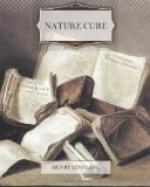Obviously, Nature does not intend that these mineral elements should enter the organism in the inorganic form, and therefore the organs of depuration are not able to neutralize and eliminate them.
Thus, for instance, any amount of iron may be taken in vegetable or herb extracts, or in the vitochemical remedies, but this will not be seen in the eye. Whatever is taken in excess of the needs of the body will be promptly eliminated.
If, however, similar quantities of iron be taken for the same length of time in the inorganic, mineral form, the iron will accumulate in the tissues of stomach and bowels, and begin to show in the iris in the form of a rust brown discoloration in the corresponding areas of the digestive organs, directly around the pupil.
In similar manner sodium, which is one of the most important mineral elements in the human body, if taken in the inorganic form, will show in a heavy, white rim along the outer edge of the iris. Sulphur will show in the form of yellowish discolorations in the area of stomach and bowels. Iodine in the medicinal, inorganic form, prepared from the ash of seaweeds, shows in the iris in well-defined bright red spots. Phosphorus appears in whitish streaks and clouds in the areas corresponding to the organs in which it has accumulated.
An interesting exception to this rule is our common table salt (sodium chloride), which is an inorganic mineral combination. So far, diagnosticians from the eye have not discovered any sign in the iris for it. There seems to be something in its nature that makes it akin to organic substances or, like other inorganic minerals and their combinations, it would show in the iris.
This might explain why salt is the only inorganic mineral substance which is extensively used as food by humanity in general. Also animals who, guided by their natural instincts, are the finest discriminators in the selection of foods and medicines, do not hesitate to take salt freely (salt licks) when they would not touch any other inorganic mineral.
Nevertheless, we do not wish to encourage the excessive use of salt, either in the cooking of food or at the table. Taken in considerable quantities, it is undoubtedly injurious to the tissues of the body.
Before the days of canned goods, scurvy was a common disease among mariners and other people who had to subsist for long periods of time on salted meats and were deprived of fresh vegetables. The disease manifested as a breaking down of the gums and other tissues of the body, accompanied by bleeding and much soreness. As soon as these people partook of fresh fruits and vegetables, the scurvy disappeared.
The minerals contained in these organic salts foods furnished the building-stones which imparted tensile strength to the tissues and stopped the disintegration of the fleshy structures.
The Nature Cure regimen aims to provide sodium chloride as well as the other mineral elements and salts required by the body in organic form in foods and medicines.




